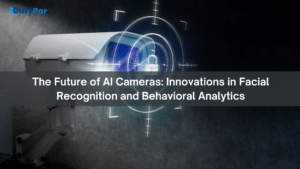 The use of AI cameras has been on the rise in recent years, with facial recognition technology being one of the most prominent features. AI cameras are equipped with machine learning algorithms and computer vision capabilities that allow them to recognize and track individuals’ faces in real-time. This technology has numerous applications, from security and surveillance to marketing and advertising.
The use of AI cameras has been on the rise in recent years, with facial recognition technology being one of the most prominent features. AI cameras are equipped with machine learning algorithms and computer vision capabilities that allow them to recognize and track individuals’ faces in real-time. This technology has numerous applications, from security and surveillance to marketing and advertising.
In this article, we will explore the future of AI cameras and how innovations in facial recognition and behavioral analytics will shape their development.
Facial Recognition Technology: Current State and Future Trends
Facial recognition technology is the most widely used application of AI cameras. The technology works by analyzing a person’s facial features, such as the distance between the eyes, nose, and mouth, to identify individuals.
The accuracy of facial recognition technology has significantly improved in recent years, with some systems achieving accuracy rates of up to 99.9%.
However, facial recognition technology has also faced criticism for its potential to violate privacy rights. The use of facial recognition technology by law enforcement agencies, for example, has raised concerns about the technology’s potential for abuse.
Facial recognition technology is the development of 3D facial recognition, which uses depth sensors to capture more accurate representations of a person’s face. This technology has the potential to improve accuracy rates and reduce the potential for false positives.
Behavioral Analytics: Enhancing AI Cameras' Capabilities
Behavioral analytics is another area of innovation in AI cameras.
By analyzing patterns of behavior, such as movement and posture, AI cameras can identify potential threats and anomalous behavior.
This technology has applications in security and surveillance, as well as in marketing and advertising.
One application of behavioral analytics is crowd analysis, which involves analyzing the behavior of crowds to identify potential threats, such as a person carrying a weapon or acting suspiciously.
This technology has applications in public spaces, such as airports and train stations, where large crowds gather.
Another application of behavioral analytics is in retail, where AI cameras can track customers’ behavior and analyze their preferences to provide personalized recommendations.
This technology has the potential to improve the customer experience and increase sales.
Surveillance and Privacy: Balancing Security and Privacy Concerns
The use of AI cameras for surveillance has raised concerns about privacy and civil liberties. Some governments and law enforcement agencies have used AI cameras to monitor citizens’ activities, raising concerns about the potential for abuse.
To address these concerns, some companies are developing privacy-focused applications of AI cameras. One such approach is federated learning, which involves training AI models on data from multiple sources without sharing the data itself. This approach can improve the accuracy of AI models while protecting individuals’ privacy.
Another approach to balancing security and privacy concerns is through the use of explainable AI. This technology involves developing AI models that can explain their decision-making processes, making them more transparent and accountable.
Conclusion: The Future of AI Cameras
AI cameras are rapidly evolving, with facial recognition technology and behavioral analytics being two areas of innovation. While these technologies have the potential to improve security and enhance the customer experience, they also raise concerns about privacy and civil liberties.
To ensure that AI cameras are developed in a way that balances security and privacy concerns, companies must adopt ethical and privacy-focused approaches. By doing so, we can harness the power of AI cameras to create a safer and more personalized world for everyone.
